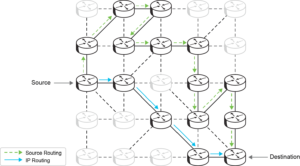Introduction
Segment Routing (SR) is a contemporary routing model that simplifies the architecture by abstracting the process of directing data packets through a network. Unlike traditional methods that may involve dynamic state information distributed across the network, Segment Routing uses source routing. Essentially, a list of instructions, called segments, is embedded into the packet header. Each segment specifies a particular function or path the packet should follow to reach its destination. The innovation in SR lies in its ability to pre-define these segments, creating a highly scalable and versatile architecture. Cisco implementation of Segment Routing can be used over both MPLS (Multiprotocol Label Switching) and IPv6 networks, making it applicable across various infrastructures.
In modern networks, Segment Routing offers several essential advantages. One of the most significant benefits is its ability to streamline network operations.
- SR reduces the complexity typically associated with scaling large-scale networks by centralizing control- and data-plane functionalities. This leads to easier and more effective network management and operation, which is crucial as network size and demand grow.
- Additionally, SR enhances network programmability, allowing operators to define traffic paths as desired without complex signaling protocols. This level of control enables effective traffic engineering, optimizing network resources and ensuring performance.
- The inherent scalability of SR supports the seamless integration of new services and network capacity expansion. As a result, it is well-suited for next-generation network architectures driven by cloud computing, 5G, and the Internet of Things. Thus, Segment Routing simplifies management and provides a solid foundation for future network innovations.
What Is Segment Routing?
Segment Routing is a modern approach to network routing that simplifies traffic management and improves network efficiency. SR uses a source-based routing system. Here, the source of the packet decides the route by encoding the path in the packet header as a series of segments. Each segment gives a specific instruction, such as sending the packet to a certain node or along a specific path.
The main advantage of Segment Routing is that it simplifies network operations and reduces control systems’ complexity. By allowing the source to control the packet’s route, SR removes the need for complex signaling protocols, such as LDP, leading to better use of network resources and easier implementation of advanced features, such as Traffic Engineering (TE) and Fast Reroute (FRR).
Segment Routing differs from traditional routing, which relies on stateful protocols and complex signaling. Traditional methods, such as MPLS-TE, require maintaining network states for each flow, which can be resource-heavy and complex in large networks. They often need additional protocols, such as RSVP-TE, for managing traffic flows, adding to the complexity. In contrast, Segment Routing is stateless, meaning the necessary information is in the packet header and not maintained in the network. This approach simplifies operations, as there is less state to manage, allowing for more scalable and flexible network designs.
How Segment Routing Works
In Cisco implementation of Segment Routing, traditional Interior Gateway Protocols, such as IS-IS (Intermediate System to Intermediate System) and OSPF (Open Shortest Path First), are extended to support Segment Routing. These extensions allow the protocols to distribute Segment Identifiers (SIDs) throughout the network.
- For IS-IS, the extensions include new TLVs (Type-Length-Value objects) that carry information about Node-SIDs, Adjacency-SIDs, and the Segment Routing Global Block (SRGB).
- Similarly, OSPF uses Opaque LSAs (Link State Advertisements) to advertise SR information, ensuring that routers within the network have a consistent and comprehensive view of the SID space.
These enhancements allow IS-IS and OSPF to efficiently propagate SR-related data, replacing traditional protocols, such as LDP and RSVP, and simplifying the network control plane.
Segment Routing (SR) fundamentally changes how packets are routed through a network. In Cisco implementation, SR uses a source-routing paradigm where the source node determines the path a packet will take. This path is encoded in the packet header as a sequence of Segment Identifiers. Each SID represents a specific instruction, such as forwarding the packet to a particular router or along a predefined path. This method eliminates the need for traditional signaling protocols, reducing network complexity and enhancing scalability.

When a packet is generated, the source router assigns a series of SIDs to the packet header. These SIDs are drawn from the Segment Routing Global Block (SRGB), a set of MPLS labels reserved for SR purposes. As the packet traverses the network, each router along the path reads the next SID in the stack and performs the corresponding action. This action could be a simple forwarding decision, such as sending the packet to the next hop, or a more complex operation, such as steering the packet through a specific sequence of nodes.
The power of Segment Routing lies in its ability to provide explicit routing without maintaining per-flow state in the network. Traditional methods like MPLS-TE require each router to maintain state information for every flow, which can become cumbersome in large networks. In contrast, SR encapsulates the routing instructions within the packet, so the network only needs to understand and execute these instructions, not store them. This stateless nature of SR simplifies network operations and enhances scalability.
Cisco Segment Routing supports SR-MPLS and SRv6, allowing it to operate over MPLS and IPv6 data planes. SR-MPLS uses MPLS labels as SIDs, while SRv6 uses IPv6 addresses, embedding the SID information within the IPv6 header. This dual compatibility ensures that SR can be deployed in diverse network environments, leveraging existing infrastructure investments while enabling new capabilities.
Key Features of Cisco Segment Routing
SR-MPLS (Segment Routing with MPLS)—SR-MPLS leverages the existing MPLS infrastructure to implement Segment Routing. In SR-MPLS, packets are forwarded based on a stack of labels, each representing a segment in the network. These labels are known as Segment Identifiers. The main advantage of SR-MPLS is its compatibility with existing MPLS deployments, allowing for a smooth transition to Segment Routing without extensive infrastructure changes. Cisco implementation supports various types of SIDs, including Node-SIDs, which identify specific routers, and Adjacency-SIDs, which represent direct connections between routers. This flexibility allows for precise control over packet paths and simplifies network operations by reducing the dependency on complex signaling protocols, such as RSVP-TE.
SRv6 (Segment Routing with IPv6)—SRv6 extends the principles of Segment Routing to IPv6 networks. In SRv6, the segment list is embedded directly within the IPv6 packet header, utilizing the Segment Routing Header (SRH). Each segment is represented as a 128-bit IPv6 address, allowing for a scalable and flexible routing mechanism. SRv6 not only facilitates traditional routing and traffic engineering tasks but also supports advanced network functions, such as service chaining and network slicing. Cisco SRv6 implementation integrates seamlessly with IPv6, enabling the use of existing IPv6 infrastructure while providing enhanced capabilities for network programming and automation.
Fast Reroute Mechanisms—One of the critical features of Cisco Segment Routing is its robust Fast Reroute mechanisms, designed to ensure high network availability and quick recovery from failures. FRR provides rapid failover by pre-computing backup paths and immediately redirecting traffic in case of link or node failures. In SR-MPLS, FRR uses the concept of Loop-Free Alternates (LFA) and Remote LFAs (RLFA) to provide backup paths. These mechanisms allow for sub-50ms failover times, minimizing packet loss and maintaining service continuity. Cisco FRR implementation is crucial for delivering reliable and resilient network services, which are important for mission-critical applications.
Traffic Engineering and Path Optimization—Traffic Engineering is a vital capability of Cisco Segment Routing, allowing for optimizing network resource utilization and managing traffic flows. By using explicit path control, network operators can direct traffic along specific routes that meet predefined performance criteria. Segment Routing simplifies TE by eliminating the need for complex signaling protocols. Instead, paths are defined through a sequence of SIDs, providing fine-grained control over traffic distribution. Cisco Segment Routing supports dynamic path optimization, enabling the network to adapt to changing traffic patterns and conditions, improving overall network efficiency and performance.
Network Programming and Automation—Network programming and automation are core to Cisco Segment Routing, enabling the creation of highly flexible and programmable network architectures. Segment Routing’s stateless nature allows for implementing advanced network functions without requiring additional state information within the network. This is achieved through network programming constructs, such as segments, which can represent various network services and functions. Cisco Segment Routing solutions support extensive automation capabilities, integrating with Software-Defined Networking (SDN) controllers and network orchestration tools. This integration facilitates automated path computation, policy enforcement, and service provisioning, reducing operational complexity and accelerating service deployment.
Segment Routing Benefits
Segment Routing (SR) offers several key benefits, making it an attractive solution for modern network architectures:
- Simplified Network Operations: SR significantly reduces the complexity and operational overhead in the control plane by removing the need for complex signaling protocols, such as RSVP-TE. This simplification makes the network easier to manage and maintain and speeds up the deployment of new services.
- Enhanced Traffic Engineering: SR allows for precise path control and optimization using Segment Identifiers. This capability enables network operators to direct traffic along routes that meet performance requirements, improving overall network efficiency and ensuring optimal resource use.
- Scalability: The stateless nature of SR means that network devices do not need to maintain per-flow state, reducing the burden on network infrastructure. This makes SR well-suited for large-scale networks and environments with rapidly changing traffic patterns.
- Robust Fast Reroute Mechanisms: SR provides strong FRR mechanisms that ensure high network availability and resilience. In case of a failure, pre-computed backup paths allow for near-instantaneous traffic rerouting, minimizing packet loss and maintaining service continuity.
- Enhanced Network Automation and Programmability: SR enhances network automation and programmability by integrating SDN controllers and orchestration tools. This integration enables automated path computation and policy enforcement, reducing manual intervention and accelerating service provisioning.
Future Trends and Developments
Segment Routing (SR) is set to be a key feature in the next generation of network technologies as network demands continue to grow. One emerging trend is integrating SR with 5G networks. The flexibility and efficiency of SR can significantly enhance network slicing and support diverse service requirements. Additionally, the adoption of SRv6 is gaining traction because of the increasing deployment of IPv6. SRv6 can provide granular network control and support advanced use cases, such as service chaining and micro-segmentation, making it a critical technology for future network architectures.
Cisco is at the forefront of Segment Routing innovation, continually enhancing its solutions to meet the evolving needs of future networking. Cisco roadmap includes developing more advanced SRv6 features, improving interoperability, and expanding automation capabilities. Innovations, such as intent-based networking and AI integration for predictive analytics, are expected to further optimize network operations and performance. Cisco also focuses on enhancing security within SR, developing mechanisms to protect against emerging threats, and ensuring robust network protection.
In conclusion, Segment Routing represents a transformative approach to network management, offering significant benefits in simplicity, scalability, and efficiency. As technology evolves, staying informed about emerging trends and advancements is crucial for network professionals. Cisco ongoing innovations and strong commitment to Segment Routing make it a reliable partner for organizations looking to modernize their networks. It is recommended that network operators explore the potential of SR, particularly SRv6, and consider integrating it into their future network strategies to achieve optimal performance and resilience.
Enrolling in a Cisco Segment Routing course is highly recommended to gain a deeper understanding and practical knowledge. This course provides comprehensive training on the latest SR technologies and best practices, equipping network professionals with the skills needed to leverage SR effectively.
